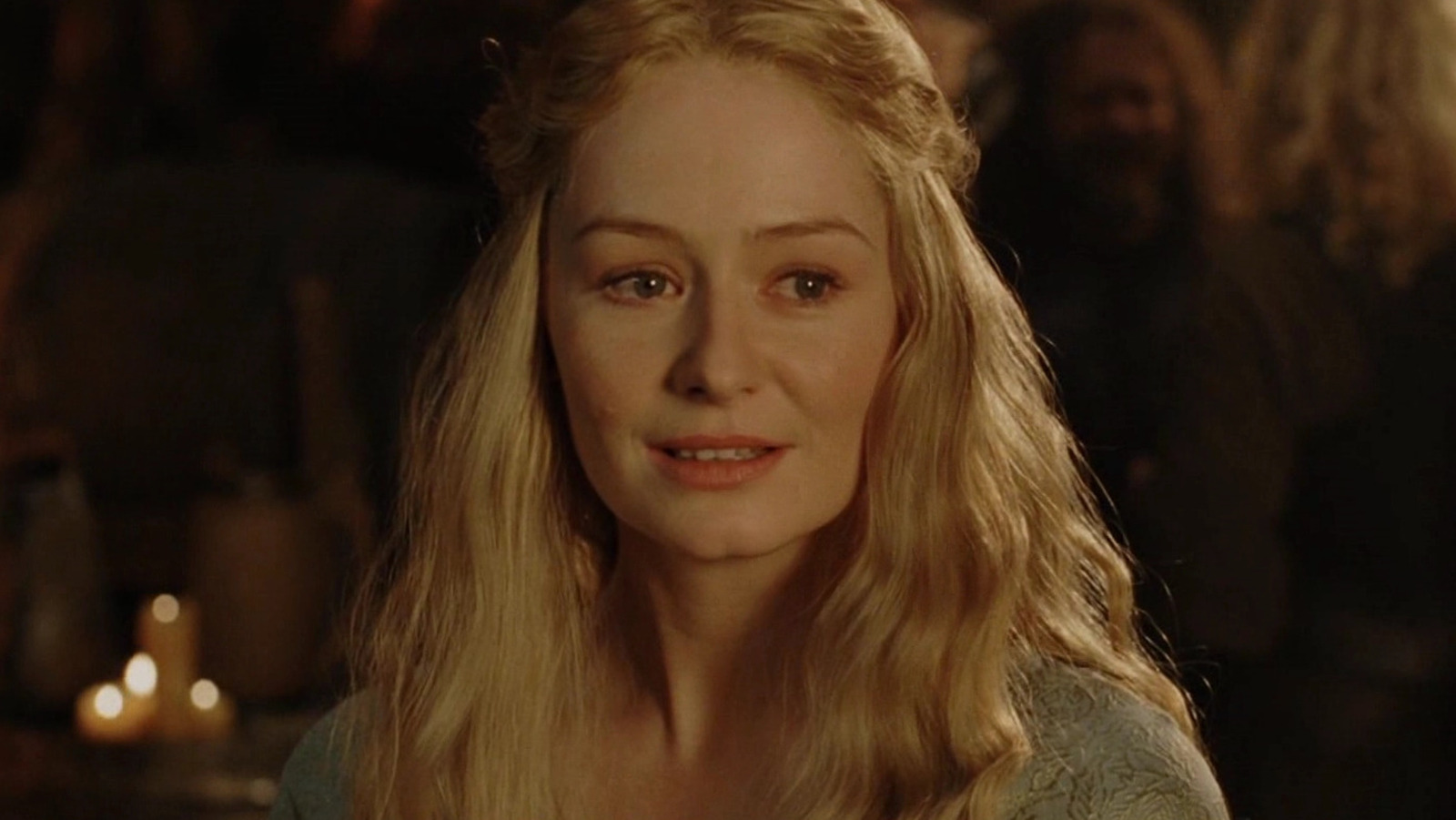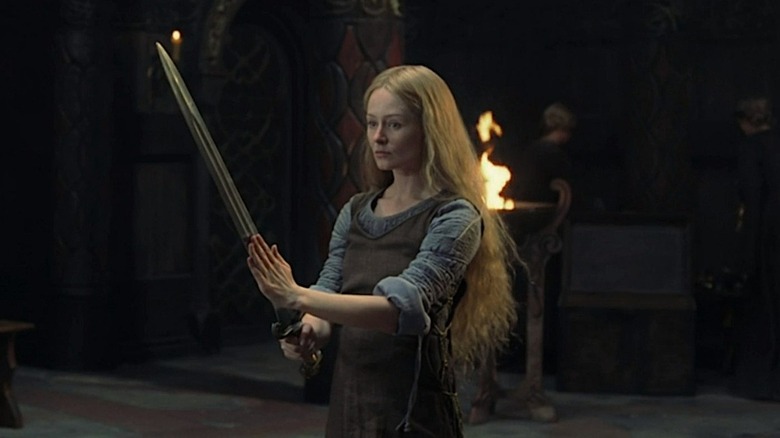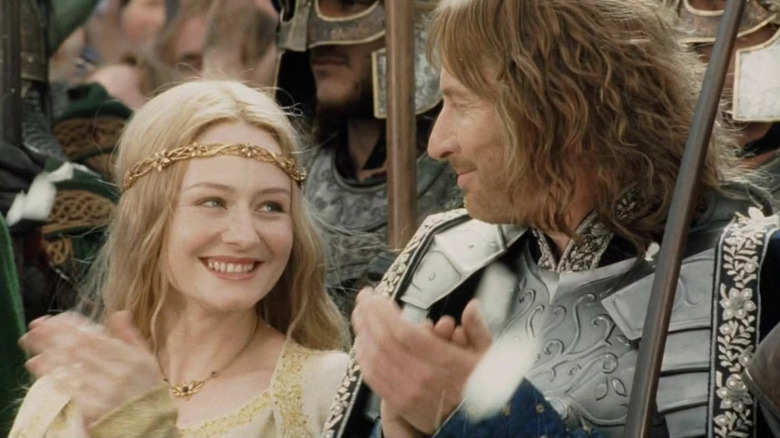
As a seasoned gamer and ardent fan of the “Lord of the Rings” saga, I find Éowyn’s character to be one of the most captivating and relatable. Her journey from a depressed and desperate warrior maiden to a healer and the Lady of Ithilien is nothing short of inspiring.
Éowyn is significantly involved in the narrative of “The Lord of the Rings”. During “The Two Towers”, she plays a crucial role in guiding Rohan’s people to safety amidst Saruman’s Uruk-hai army invasion. In “The Return of the King”, she bravely slays the Witch-king, which is an iconic scene often highlighted as one of the best from the “The Lord of the Rings” trilogy. Throughout this journey, Éowyn is portrayed as a deeply troubled and desperate character, yearning for freedom from her life and ultimately seeking a glorious death on the battlefield.
Regardless of her initial melancholic undertones, Éowyn’s valiant deeds ultimately lead her to retire her gear tainted by the Nazgûl, marry Faramir from Gondor, and enjoy a serene life filled with healing. In essence, Éowyn’s journey is one that transitions from sorrow to victory. However, the inspiring destiny of the battle-hardened, embittered, and seemingly hopeless warrior maiden in “The Lord of the Rings” may not be immediately apparent in Peter Jackson’s groundbreaking movie trilogy.
In the movie adaptation of “The Lord of the Rings,” Miranda Otto’s character, Éowyn, and David Wenham’s character, Faramir, share a blissful moment after the destruction of the Ring in a single scene. In the extended versions, there’s an additional short scene (around a minute long) set in Gondor’s Houses of Healing, where Faramir consoles a troubled Éowyn and they eventually hold hands. J.R.R. Tolkien provides a more comprehensive portrayal of how these characters grow closer following Éowyn’s brave actions on the battlefield and what happens to her thereafter in his original work.
Who is Éowyn?

Éowyn is a valiant female warrior hailing from Rohan, more specifically known as a shield-maiden. To put it simply, she is a skillfully trained battlewoman, and not just any, but a royal one. Her mother was Théodwyn, who was King Théoden’s sister. Tragically, when Éowyn is only 7 years old, her father, Éomund, falls in battle against orcs, and shortly after, her mother succumbs to an illness. This leaves Éowyn and her elder brother, Éomer, as orphans, under the care of their uncle. Raised within the king’s household, she bears witness to the harsh realities of his deterioration before the events of “The Lord of the Rings,” causing her to plunge into a profound melancholy.
There is even a moment in both the books and Jackson’s films, where Éowyn explains what she fears. In “The Return of the King” book, she starts by saying, “I am of the House of Eorl and not a serving-woman. I can ride and wield blade, and I do not fear either pain or death.” When asked what she does fear, she responds, “A cage […] To stay behind bars, until use and old age accept them, and all chance of doing great deeds is gone beyond recall or desire.”
This paves the way for Éowyn’s daring move, in which she dons warrior attire and joins the fray at the Battle of the Pelennor Fields. In this conflict, she achieves immortal glory by slaying the Witch-king but narrowly escapes death herself. She is then carried to the healing facilities within Minas Tirith (the city’s hospital), where Aragorn assists in her recovery before departing for the siege of the Black Gate. As a result, Éowyn recovers physically but remains emotionally and mentally troubled after this harrowing experience.
How does Éowyn’s story end?

The turning point in Éowyn’s fate doesn’t stem from Aragorn’s healing, but rather from the inspiring words of one more exceptional character within J.R.R. Tolkien’s works: Faramir. A son of the Steward of Gondor and brother to Boromir, Faramir himself has been wounded and taken to the Healing Houses. After recovering, he encounters Éowyn and they spend numerous days conversing. Over time, Faramir’s insightful and encouraging words gradually help ease the hardened heart of his battle-worn companion.
In “The Return of the King” novel, as Éowyn heals alongside Faramir, Tolkien pens, “Then Éowyn’s heart transformed, or perhaps she finally grasped it. And suddenly, her winter thawed, and sunlight graced her.” Later, Éowyn confides in her new love, Faramir, about this change, stating, “I stand within Minas Anor, the Tower of the Sun… and see! The Shadow has vanished! I will no longer be a shieldmaiden, nor compete with great riders, nor find joy only in songs of war. I will become a healer, and cherish all that flourishes and is not lifeless.
Following the destruction of the One Ring, Éowyn returns to her native land for the burial of her uncle. Subsequently, she travels to Gondor and, together with Faramir, settles in the idyllic region of Ithilien (a place where Frodo and Sam cooked rabbits). It’s worth noting that Éowyn is recognized as the Lady of Ithilien. Additionally, their family lineage is mentioned in “The Lord of the Rings,” with their grandson, Barahir, contributing to the recording of Middle-earth’s history.
Approximately at the age of 37, the latest information we have about Éowyn suggests that she was honored with significant gifts, as mentioned in the appendices of “The Return of the King,” from King Éomer and the Lady Éowyn, who resided in Ithilien.
Here it is: In a nutshell, Éowyn’s tale unfolds from sorrow to victory. What makes it even more exciting for fans is that Miranda Otto will bring her character back to life when the Lady of Ithilien reappears in Warner Bros.’ anime “The War of the Rohirrim,” set to premiere at the end of 2024.
Read More
- 10 Most Anticipated Anime of 2025
- USD CNY PREDICTION
- Pi Network (PI) Price Prediction for 2025
- Gold Rate Forecast
- Silver Rate Forecast
- USD MXN PREDICTION
- Brent Oil Forecast
- USD JPY PREDICTION
- EUR CNY PREDICTION
- How to Watch 2025 NBA Draft Live Online Without Cable
2024-09-08 17:00